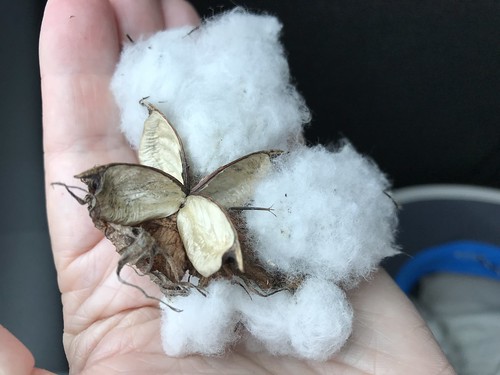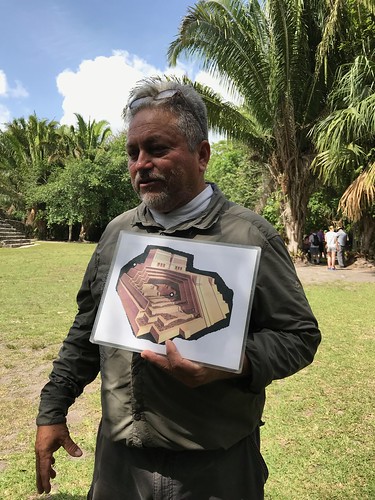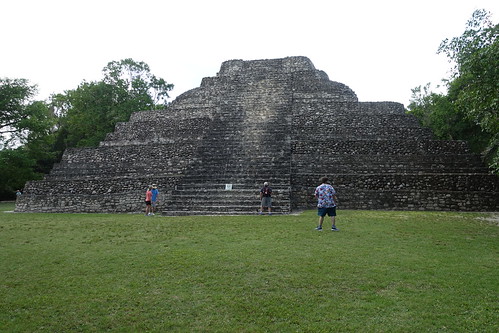Our Celebrity cruise ship docked in Puerto Costa Maya for the day. Unlike many cruise ship passengers who simply headed to the beach for a few hours of leisure or browsed through the local shops, we arranged for a small group half-day tour using the Shore Excursions Group website.

ARRANGING FOR A SMALL GROUP TOUR TO CHACCHOBEN RUINS
Opting for an onshore excursion vendor can be stressful. Cruise ship passengers need to have confidence that the tour will be completed with enough time to return to the ship before the ship sails out of port. It can be a costly mistake to return after the ship has sailed. We chose to book our trip online because Costco Travel recommended the Shore Excursions Group, and we had positive experiences with this company on previous cruises.
We walked several blocks to the designated pick up point at the Native Choice Tours office and joined a small group of passengers who were equally interested in visiting a famous Mayan ruin considered to be one of the largest Pre-Columbian cities found in the Los Lagos region. The Ancient History Encyclopedia dates this community to approximately 200 BCE. After the site was abandoned for an unknown reason around 1000 C.E., archeologists didn’t begin exploring the area until the 1970s. Efforts to restore the Mayan ruins began in the 1990s, and the site was opened to the public in 2002. Currently, tourists can only view a small portion of this ancient Mayan community.

Pineapple Vendors along the road to site
DRIVE TO CHACCHOBEN RUINS AND BACKGROUND INFORMATION
As we drove in a minibus on a flat road, we passed through a few cattle and agricultural communities with several pineapple vendors. Hugo Villagomez Villalobos, a former educator, provided a quick history and geography lesson during our one-hour drive. Surprisingly, the porous ground only creates underground rivers, so the region does not have any above-ground rivers. Droughts have been a persistent issue for centuries.
While it was only mid-June, we could understand why many foreigners feel uncomfortable in this humid environment. Our small group hopscotched our way through the ruins by stopping in places shaded by mature deciduous trees. The sun’s rays were intense and constant as we meandered on a well-groomed circular path. Along the way, Hugo continued to share a plethora of facts as I jotted down a few key points.

Pathway through the jungle
NATIVE VEGETATION
Like other indigenous people, the Mayans used local plants for medicine and clothing. We were shown a leaf that midwives used to help coagulate blood during childbirth, another leaf that was smoked to control diabetes, and we smelled another leaf that reminded us of a combination of cinnamon and cloves. Hugo told us that the last medicinal plant was a numbing agent like Novocain. I took the challenge and put a small piece in my mouth. It definitely worked.

Spanish Magueyito Morado plant
I stopped to admire a Spanish Magueyito Morado, a small shrub with long dark green stems with a few hints of contrasting purple. Like many of the other indigenous plants, it is known for its ability to treat bronchial ailments and can also be used as an antiseptic. Hugo also singled out a cotton plant that grows taller than the ones found in the southern part of the U.S. The Mayans used this plant to make their clothing.

Indigenous Cotton Plant
MAYAN RUINS
Mayans believed that the Earth was flat and that a god was responsible for holding the sky overhead. They worshipped a multitude of gods who lived either on the mountaintops or in caves. We all chuckled when our guide mentioned a chocolate god. To balance nature, pyramids were built on higher ground with the temple at the top and a cave below.
Plaza B and Temple 24
Most of our group congregated in the spacious Plaza B to take pictures of a nameless step pyramid simply labeled Temple 24. By combining powdered limestone, clay, stones, and water, the Mayans created concrete to secure the layers of rocks.

Temple 24
Irregularly shaped stone steps led to the apex, but visitors are restricted to just a few stairs at the very bottom. While it was not possible to see inside, we were shown a drawing that revealed inner chambers. Hugo used the analogy of a Russian stacking doll as he flipped through pictures that showed a few internal layers.

Hugo showing the inside of Temple 24
Great Plaza
We stopped for a short while in the Great Plaza so we could use our imaginations to visualize where the Mayans traded everyday necessities in the marketplace. Ground vegetation partially obscured some of the ruins, and enormous trees found in a mid rainforest offered a protective canopy over what remained of the stone stairs and stone buildings. The steps once led to the civic and ceremonial spaces of the plaza. Hugo also pointed to other stone ruins where affluent residents once resided.

Great Plaza
Temple 1, Temple of the Vessels and Stelae
After walking a short distance, Hugo took part of the group on a more accessible route, while the rest of us climbed a wide and steep staircase. When we reached the pinnacle, we came upon another archeological site where Temple 1 stands. Once again, archeologists have yet to determine the structure’s original name. It towers more than a dozen meters and adds to the fascination of this ancient culture. Hugo described this building as the ultimate temple in Chacchoben where rituals took place, especially fertility ceremonies.

Steps leading to Temple 1
Since this was an agricultural society, many of the ceremonies focused on the fertility of the land. Scientists also theorize that this structure was a solar temple. During the summer solstice, the early morning sunlight aligns with Temple 1.

Temple 1
Near Temple 1 is a smaller lunar temple, referred to as the Temple of the Vessels. At the back of this temple is a partially covered area with a thatched roof. The covering was added to protect original fragments of plaster with red pigment. According to Hugo, the red colored stucco represents the direction east as well as life. This culture believed that the sun was reborn every day.

Temple of the Vessels with Thatched Roof protected area in the back
Worn out stone tablets, or stelae, were also on display. While the stelae's primitive writing is indecipherable, Hugo mentioned that it is believed that the tablets convey historical information.

Stone Tablets with Ancient Writing
WILDLIFE ENCOUNTER
One can never anticipate what may happen in a jungle environment. Three monkeys decided to draw our attention away from the ruins by swinging from branch to branch in adjacent trees. Their performance quickly reminded us to be on the lookout for other wildlife. Disappointingly, no other wildlife chose to entertain us during the rest of our journey.
CONCLUDING THOUGHTS
After our two-hour tour, all of the participants were guzzling water and were thrilled to return to the air-conditioned minibus. Disappointingly, this archeological site had minimal signage. The ruins lacked interpretive signs, and the main office did not have any pamphlets. Visitors who are unfamiliar with Mayan culture and are interested in learning about the Chacchoben ruins should arrange for a guided excursion. Without Hugo’s insight, we would have not have appreciated or understood the significance of these ruins. By walking through these Mayan ruins, history came alive in Chacchoben.

Temple 24
Sandy Bornstein, the History Comes Alive Through Travel Editor for Wandering Educators, has visited more than 40 countries and lived as an international teacher in Bangalore, India. Sandy’s award-winning book, May This Be the Best Year of Your Life, is a resource for people contemplating an expat lifestyle and living outside their comfort zone. Sandy writes about Jewish culture and history, historical sites, family, intergenerational, and active midlife adventures highlighting land and water experiences.
All photos courtesy and copyright Sandy Bornstein
